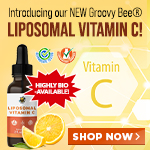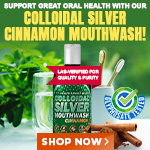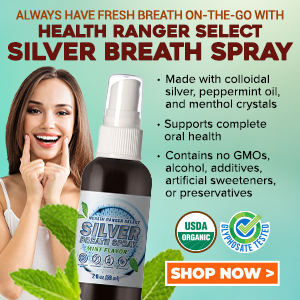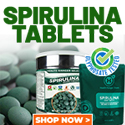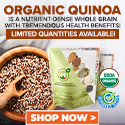Edible water bottles could reduce plastic waste
Thursday, May 15, 2014 by: PF Louis
Tags: plastic waste, edible water bottles, pollution
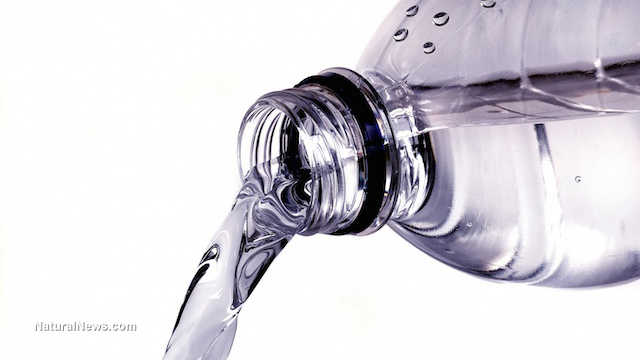
- TAKE IT DOWN Act advances in Congress amid free speech concerns
- Survival 101: Dangerous places to avoid when disaster strikes
- Hospital staffers sound alarm after 10 nurses were diagnosed with BRAIN TUMORS
- New studies ignite debate: Fluoride linked to autism and ADHD, prompting calls for policy reassessment
- DOJ and ATF kill Biden’s “Zero Tolerance” firearms dealer policy
- “Prepare Tribe: Prepare, Protect, Provide” on BrightU: How to build a disaster-proof shelter in the middle of nowhere
- Federal appeals court authorizes DOGE access to Education, Treasury and OPM records
- Sovereign debt paradox: U.S.-China mutual holdings fuel geopolitical tensions
- Barley: A nutrient-dense ancient grain with modern benefits
- Children’s Health Defense stands firm: Based on SCIENCE and personal experiences, the MMR vaccine is NEITHER SAFE nor EFFECTIVE
- Sen. Ron Johnson accuses CDC official in charge of COVID-19 injections of deleting records amid Congressional GOP scrutiny
- Analysis: The coming economic collapse, a mass uprising and Trump's three secret weapons to halt the growing revolt
- Widespread social and economic unrest: Steve Quayle issues urgent financial warning of imminent asset collapse in new interview with Mike Adams
- Aerosolized bioweapons? Strange “diploid biomasses” falling out of the sky in Florida captured under the microscope
- Fauci is back in the limelight, and he’s busy promoting a future COVID or FLU pandemic
- The ancient superfood revival: Discovering the healing power of Job’s tears
- Tulsi Gabbard leads charge against the Biden regime’s global censorship of the 'Disinformation Dozen'
- Rafael Medoff explores the role of Jabotinsky in the rise of Revisionist Zionism in “Militant Zionism in America”
- Tulsi Gabbard leads charge against the Biden regime’s global censorship of the 'Disinformation Dozen'
- Fauci is back in the limelight, and he’s busy promoting a future COVID or FLU pandemic
- Aerosolized bioweapons? Strange “diploid biomasses” falling out of the sky in Florida captured under the microscope
- Analysis: The coming economic collapse, a mass uprising and Trump's three secret weapons to halt the growing revolt
- Widespread social and economic unrest: Steve Quayle issues urgent financial warning of imminent asset collapse in new interview with Mike Adams
- Kiss Your Genetic Privacy Good-Bye! 23andMe Gets Green Light to Sell Your Intimate Genetic Details to Anyone They Want
- Tulsi Gabbard takes aim at censorship: Justice for the ‘Disinformation Dozen’
- Mike Adams releases country western hit single: Goin’ Back in Time is Comin’ Home
- U.S. lawmakers investigate Meta over alleged China collaboration
- CLOT SHOT PLANDEMIC UNFOLDING: Fibrous, rubbery clots caused by covid injections have prion-like seeding activity
- Chemtrails unveiled: How the CIA and Big Business are manipulating the weather for profit
- How Israeli military-connected corporations are secretly controlling your online privacy
- European Court of Justice: Healthcare professionals who promoted or administered COVID-19 vaccines are CRIMINALLY LIABLE for any harm caused
- DEATH by VACCINE or face PRISON time: Canadian Freedom Convoy leaders CONVICTED for protesting forced vaccination during the Covid Plandemic
- Defunding DEADLY mRNA jabs: Government funding for mRNA technology being scrutinized and sidelined until proven "safe and effective" for real
- Federal employees whine over DOGE's new directive requiring them to do a 5-point summary of weekly accomplishments
- U.S. approves new Russian ambassador as diplomatic thaw continues
- Curcumin’s ancient healing power supercharges muscle recovery, and its effects are compounded with anti-inflammatory foods and supplements
- Newly released JFK files reveal Pentagon's role in creating Lyme disease and covid in the same lab
- Analysis: The coming economic collapse, a mass uprising and Trump's three secret weapons to halt the growing revolt
- Mike Adams releases country western hit single: Goin’ Back in Time is Comin’ Home
- Aerosolized bioweapons? Strange “diploid biomasses” falling out of the sky in Florida captured under the microscope
- Kiss Your Genetic Privacy Good-Bye! 23andMe Gets Green Light to Sell Your Intimate Genetic Details to Anyone They Want
- Dr. Mike Yeadon releases 15-minute testimony - WATCH - about genocidal intent of COVID “vaccines”
- Trump reverses course on Gaza plan, says “nobody is expelling Palestinians”
- MEDICAL BOMBSHELL: FDA admits Covid mRNA 'Vaccines' CAUSE CANCER
- European Court of Justice: Healthcare professionals who promoted or administered COVID-19 vaccines are CRIMINALLY LIABLE for any harm caused
- The Health Ranger releases “Vaccine Zombie” song and music video, using AI-animated zombies for the music video
- 5 Simple steps to boost your brainpower: How to strengthen executive function in a distracted world
- A lack of integrity in Academia: Harvard professor found GUILTY of fraudulent research to promote CRT theory
- Federal employees whine over DOGE's new directive requiring them to do a 5-point summary of weekly accomplishments
- EPA advisor admits the agency is funneling billions to climate groups ahead of Trump’s return to White House
- California's social media censorship law struck down: A victory for free speech or a threat to online safety?
- Space war brewing? Russia threatens to destroy Starlink satellites
- Survival 101: Effective EMF blocking techniques
- Rep. Nancy Mace introduces bill to ban biological males from female facilities on federal property
- Red Cross issues warning to stop blood plasma donations from vaccinated people
- Scientists confirm: GENIUS brain function can be spontaneously unleashed in humans without any apparent cause
- EPA advisor admits the agency is funneling billions to climate groups ahead of Trump’s return to White House
- HYSSOP: What research reveals about the health benefits of this ancient holy herb
- Two containers with completed ballots fall out of truck in Florida
- Newly released JFK files reveal Pentagon's role in creating Lyme disease and covid in the same lab
- Global leaders unite to clamp down on “misinformation” with UN-backed Cascais Declaration
- BREAKING: 2025 NDAA authorizes mandatory military draft of WOMEN across America… as Pentagon pursues global NUCLEAR war with both Russia and China at the same time
- Michael Yon warns of a ZIONIST TAKEOVER in Trump’s second administration
- Ozempic and Wegovy weight loss drugs are injectable LIZARD VENOM PEPTIDES that may unleash a devastating wave of organ failure… side effects align with symptoms of SNAKE BITES
- The Health Ranger releases “Vaccine Zombie” song and music video, using AI-animated zombies for the music video
- Mike Adams releases country western hit single: Goin’ Back in Time is Comin’ Home
- BOMBSHELL: DNA testing kits are a SCAM to develop ethnic-specific bioweapons
- Israeli soldiers accused of even more torture and abuse in the West Bank
- These 13 countries just signed an agreement to engineer a global FAMINE by destroying food supply
- NASA admits that climate change occurs because of changes in Earth’s solar orbit, and NOT because of SUVs and fossil fuels
- Fully vaccinated about to see “tsunami” of illness and death, warns virologist
- RFK Jr. clears key hurdle: Sen. Susan Collins backs controversial HHS nominee, signaling a new era for health policy
From a 2006 United Nations Environmental Program (UNEP) report: Over 46,000 pieces of plastic litter are floating on every square mile of ocean today. In the Central Pacific, there are up to 6 pounds of marine litter to every pound of plankton.
Granted, this litter is in tiny pieces, as it breaks down. Sometimes it's even hard to notice from a ship or boat. But those tiny pieces are composed of toxic materials that threaten the biodiversity of the ocean's marine life.
As mentioned in a recent Natural News article by this writer, there's a lot of litter on the ocean floors, and most of it is plastic. The stuff on the surface is bad enough. As those surface plastics degrade and break down, their toxic plastic residue threatens plankton, an important aspect of marine life that converts carbon dioxide to oxygen in our atmosphere.
But a lot of it sinks to the ocean floor as microplastics that threaten marine life in various ways (http://www.naturalnews.com).
What to do about it
A recent invention that grabbed headlines on science publications and media science sections was a weird edible plastic water bottle. This invention has a long way to go before it can be considered a viable, marketable solution.Currently, it's limited in size and lacks the mechanics for sealing it with a cap or some sort of plug. And thus far the human testing has had mixed results.
Some say it reminds them of breast implants, and others say it's like holding a jellyfish. Hard to swig from that while driving around, eh?
The container itself is easily edible, especially if artificially flavored or spiked with MSG (sarcasm). It was inspired by an earlier model of edible floating containers made by a process called "spherification" used by world-renowned Spanish chef Albert y Ferran Adria (http://www.albertyferranadria.com).
A group of designers led by Rodrigo Garcia Gonzalez at the Imperial College London have developed what they call the "Ooho water container" using the "spherification" technique. Instead of creating a bottle and then filling it with water, Gonzalez used a process that allows the bottle to take shape as it coalesces around the liquid.
Gonzalez and his team started with a frozen ball of water, then dipped it into a calcium chloride solution, forming a gelatinous layer. Then the ball was soaked in another solution made from brown algae extract, encapsulating the ice in a second squishy membrane to reinforce the structure.
The longer the water sits in the algae solution, the stronger and thicker the spherical structure. Gonzalez points out that the "main point in manipulating the water as solid ice during the encapsulation is to make it possible to get bigger spheres and allow the calcium and algae to stay exclusively in the membrane." But even the bigger spheres are small.
The issue of finding a way to transport these small containers and have them on store shelves is another problem demanding solutions. There is a recent yogurt product from Stonyfield that uses edibles to deliver yogurt balls. The designers think that may offer or inspire a solution. The public's not very keen on drinking from small slippery edible globules.
Yes, this proposal for solving the world's plastic pollution problem has many obstacles. But there is a solution that's currently available to produce actual bottles or whatever that are biodegradable.
Instead of all these issues, why not use what's available to make real bottles in any sizes that are strong and durable yet biodegradable? That's what hemp offers (http://www.hempplastic.com).
The fibers from hemp stalk are what are used to make plastic. This eliminates petroleum with chemical additives for plastic containers. They will degrade without harming the environment and provide useable bottles that consumers are used to.
Sources for this article include:
http://www.ibtimes.co.uk
http://www.smithsonianmag.com
http://www.unep.org
http://science.naturalnews.com
http://science.naturalnews.com
Plastic waste at FETCH.news
Get independent news alerts on natural cures, food lab tests, cannabis medicine, science, robotics, drones, privacy and more.
Take Action: Support Natural News by linking to this article from your website
Permalink to this article:
Embed article link: (copy HTML code below):
Reprinting this article:
Non-commercial use OK, cite NaturalNews.com with clickable link.
Follow Natural News on Facebook, Twitter, Google Plus, and Pinterest
Science News & Studies
Medicine News and Information
Food News & Studies
Health News & Studies
Herbs News & Information
Pollution News & Studies
Cancer News & Studies
Climate News & Studies
Survival News & Information
Gear News & Information
News covering technology, stocks, hackers, and more



"Big Tech and mainstream media are constantly trying to silence the independent voices that dare to bring you the truth about toxic food ingredients, dangerous medications and the failed, fraudulent science of the profit-driven medical establishment.
Email is one of the best ways to make sure you stay informed, without the censorship of the tech giants (Google, Apple, Facebook, Twitter, YouTube, etc.). Stay informed and you'll even likely learn information that may help save your own life."
–The Health Ranger, Mike Adams














